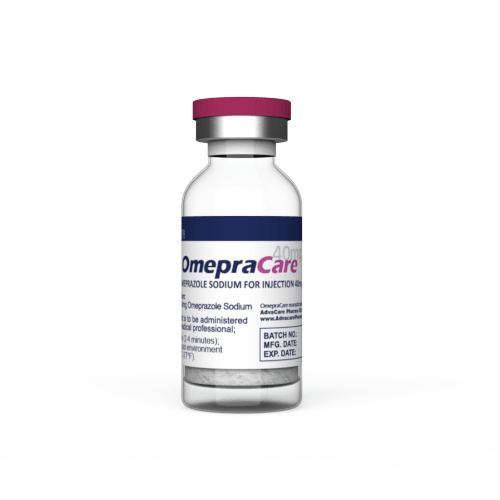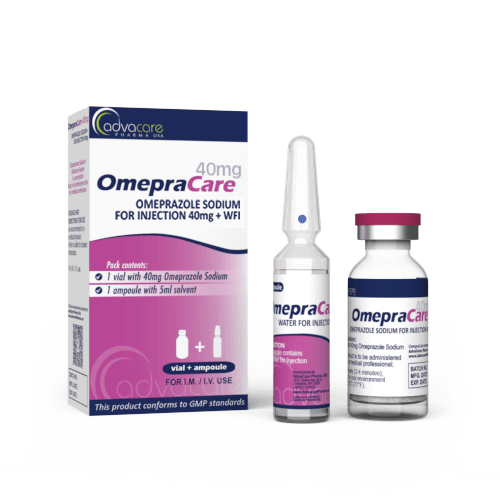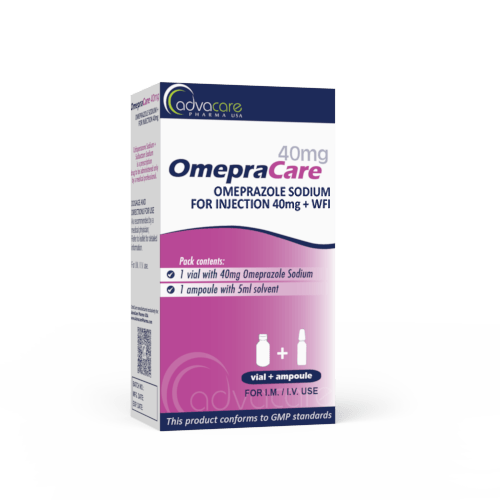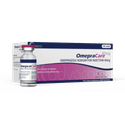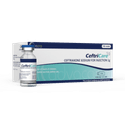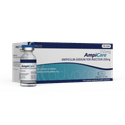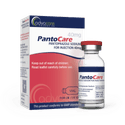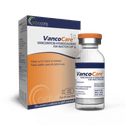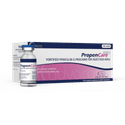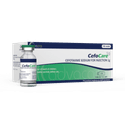- Home›
- Pharmaceuticals›
- Injections›
- Powder for Injection›
- Omeprazole for Injection
Omeprazole for Injection
Dosage
Packaging
What is Omeprazole Sodium?
Active Ingredients: Omeprazole Sodium
Omeprazole Sodium for Injection is a drug used to treat conditions and symptoms caused by excess stomach acid production. It is indicated for the treatment of peptic ulcers and conditions like acid reflux disease and esophagitis. It relieves symptoms like heartburn, coughing, and swallowing problems.
Omeprazole Sodium is also used together with antibiotics to treat gastric ulcers caused by infection with Helicobacter pylori (H. pylori). It was approved by the FDA in 1989.
Omeprazole is classified as a proton pump inhibitor. The active ingredient works by inhibiting the H+/K+-ATPase system, therefore blocking acid from being secreted into the stomach. Proton pump inhibitors typically take up to 4 days to reach full efficiency.
This drug is a weak base and is concentrated and converted to the active form in acidic environments. It acts rapidly and provides control through reversible inhibition of gastric acid secretion. Intravenous injections of omeprazole lead to a dose-dependent inhibition of gastric acid secretion in humans. There is a mean decrease in intragastric acidity after 24 hours after intravenous administration.
Omeprazole is mostly used to eradicate H.pylori together with antimicrobials. There are high rates of healing and long-term remission of peptic ulcers. It can also prevent the development of gastritis, atrophic gastritis, and gastric cancer.
The distribution of this drug is 0.3 l/kg body weight. It is completely metabolized by the cytochrome P450 system, and its metabolism is dependent on CYP2C19. Around 3% of the Caucasian and 15-20% of the Asian population lack CYP2C19 enzyme, and special caution must be taken when giving Omeprazole to these individuals. The plasma elimination half-life of Omeprazole is less than 1 hour, and there is no tendency for accumulation. Around 80% of Omeprazole is excreted through urine, while the rest of it through feces and bile.
This formulation of Omeprazole Sodium has been manufactured as a fine powder that is intended to be reconstituted for parenteral injection. It is available on its own in a box of 1, 10, or 50 vials or as a combination pack with Water for Injection. This convenient pack contains a vial of Omeprazole Sodium and an ampoule of sterile Water for Injection, which may be mixed with the Omeprazole Sodium powder and injected intravenously.
This drug is also available in the form of capsules.
AdvaCare Pharma is a GMP-certified manufacturer and exporter of Omeprazole Sodium for Injection. Our extensive pharmaceutical catalog contains a range of high-quality and cost-effective medications that are available for distribution. These medical products are manufactured in our GMP-certified facilities in China, India, and the USA.
Why choose us as your Omeprazole manufacturer?
AdvaCare Pharma, a US-owned pharmaceutical company, is a manufacturer of Omeprazole for Injection with GMP-compliant manufacturing facilities located worldwide. We conduct frequent GMP, third-party and internal facility inspections to ensure that our manufactured injectable treatments exceed the stringent requirements of importing countries and our distributors.
As a renown Omeprazole manufacturer and global supplier of 120+ pharmaceutical injection products, our global reach extends to over 65 markets ensuring that pharmaceutical distributors, hospitals, pharmacies, NGOs and government institutions receive the quality-assured treatments they need.
Uses
What is Omeprazole used for?
It is used to relieve symptoms caused by excess stomach acid production. It is used in the treatment of:
- Duodenal and gastric ulcers
- Peptic ulcers
- Gastric ulcers associated with NSAIDs
- Oesophagitis
- Ulcers caused by H. pylori bacteria (combined with other medications)
- Gastroesophageal reflux disease (GERD)
- Zollinger-Ellison syndrome
- Dyspepsia
Omeprazole is also used to prevent gastrointestinal tract bleeding in some situations.
How is Omeprazole for Injection used?
This medication is manufactured as a powder, which is packaged in a vial. As an injectable form, it is to be given directly into a vein (IV). Reconstituted solutions should be used immediately.
What dose should be given?
The exact dosage is based on the severity of the condition, age, and weight:
- For duodenal ulcers, gastric ulcers, or reflux esophagitis when oral treatment is unavailable, the usual dose is 40mg, given once per day.
- For Zollinger-Ellison syndrome, the usual initial dose is 60mg. If a higher dose is necessary, it should be divided equally and given twice per day.
Refer to a doctor or pharmacist for guidelines on dosage.
Who can use Omeprazole for Injection?
Omeprazole Sodium can be used by individuals with gastroesophageal reflux disease, peptic ulcer, and other health conditions that lead to over secretion of gastric acid. It is effective and well-tolerated in children and adults, but special considerations must be taken for some individuals.
Patients with impaired hepatic function Patients with altered hepatic function who take Omeprazole might have an increased area under the curve (AUC), indicating higher plasma concentrations.
Patients with impaired renal function The drug is eliminated through urine, and taking Omeprazole might have increased elimination time.
Geriatric The metabolism rate in older patients (75-79 years) is reduced. This drug should only be taken if recommended by a doctor.
Pregnant This drug can be used during pregnancy, but in general, all drugs during pregnancy should be avoided when possible, especially in the first trimester. Omeprazole can be excreted through milk, but there are no side effects to infants. Also, studies show that this drug has no side effects during pregnancy. However, adding any drug throughout the pregnancy should be with caution.
Is only Omeprazole for Injection enough for treating diseases?
Omeprazole Sodium is used to decrease gastric acidity in patients who have excess gastric acidity and similar clinical symptoms. However, during the treatment process of these diseases, some additional therapy might be needed depending on the current health condition of the individual. The doctor should decide about the treatment process and the combination of the drugs.
Other warnings
If the patient has any persisting illness or alarm symptoms like weight loss, vomiting, dysphagia, haematemesis, or melena, this drug should be avoided.
Omeprazole can reduce the absorption of vitamin B12. It can also increase the risk of gastrointestinal infections like Salmonella and Campylobacter.
Severe hypomagnesemia has been documented in patients who have been under treatment with proton pump inhibitors (PPIs) such as omeprazole for a duration of at least three months, with the majority of cases extending to a year. Hypomagnesemia can lead to serious manifestations, including fatigue, tetany, delirium, convulsions, dizziness, and ventricular arrhythmia. These symptoms may develop insidiously and might be easily overlooked.
In many instances, hypomagnesemia resolved following the discontinuation of the proton pump inhibitor and subsequent magnesium replacement therapy. It is important for healthcare providers to be cautious about the potential risk of hypomagnesemia in patients on long-term PPI therapy, especially if they present with symptoms suggestive of magnesium deficiency. Monitoring magnesium levels and considering alternative treatments or adjustments in medication regimens may be necessary in such cases. Patients should promptly report any unusual symptoms to their healthcare professionals to facilitate timely intervention and management.
Proton pump inhibitors can increase the risk of bone fractures in older patients. These drugs might increase this overall risk by 10-40%. These patients should take vitamin D and calcium.
Side Effects
As with all pharmaceuticals, some unwanted effects can occur from the use of Omeprazole for Injection.
Common side effects include, but may not be limited to: • headache • gastrointestinal disturbances
Seek medical attention if the following develop: • signs of an allergic reaction
Side effects are uncommon for Omeprazole. However, they might occur depending on the dose and the patient’s current health condition. In cases of critically ill patients, an irreversible visual impairment might occur. But this is only possible in rare cases and when the dose is not well adjusted.
For a comprehensive understanding of all potential side effects, consult a medical professional.
If any symptoms persist or worsen, or you notice any other symptoms, please call your doctor.
Precautions
Do NOT use Omeprazole for Injection if:
- You are allergic to any of the ingredients.
- You have been using other proton pump inhibitors.
- You have severe hypomagnesaemia.
Before treatment, consult your doctor regarding any medications you are taking to address potential drug interactions.
This medication may not be suitable for people with certain conditions, so it is important to consult with a doctor if you have any health conditions.
Patients who take this drug might feel dizziness, especially when operating or driving machinery. But this is not very common.
The magnesium levels before and during the treatment with Omeprazole should be measured. Prolonged treatment with Omeprazole might lead to hypomagnesemia. The most common symptoms are muscle twitches, vomiting, tremors, tiredness, and lack of appetite.
Some patients need to be ECG monitored due to the risk of QT prolongation.
Patients with a risk of osteoporosis should intake adequate vitamin D and calcium.
If subacute cutaneous erythematosus lupus occurs, administration of Omeprazole should be stopped. In rare instances, subacute cutaneous lupus erythematosus (SCLE) cases have been reported in patients using proton pump inhibitors (PPIs). Drug-induced SCLE may manifest weeks, months, or even years after the initial exposure to the drug. Patients affected by this condition should minimize sun exposure to alleviate symptoms.
There is a risk of gastrointestinal infection due to the decreased gastric acidity.
Older patients have an increased risk of bone fractures. Additional supplements must be taken to avoid this risk.
This drug should be used only when prescribed by a professional.
Keep this drug out of reach of children.
References
Efficacy and Safety of Omeprazole for the Treatment of Acid Peptic Disorders: A Systematic Review and Meta-Analysis
The primary objective of this study was to compare the efficacy of omeprazole with other proton-pump inhibitors (PPIs) and placebo in treating acid peptic disorders (APDs). The research analyzed data from various databases, assessing efficacy separately for erosive and non-erosive diseases.
The analysis included 10,539 participants from 12 studies and found that omeprazole significantly improved heartburn compared to placebo (RR = 2.47, 95% CI: 2.13 to 2.86, p < 0.001) and was comparable in effectiveness to five other types of PPIs. Omeprazole was identified as the most cost-effective PPI in this study.
In conclusion, omeprazole is significantly more effective than placebo and is efficient in healing ulcers and erosions associated with APDs.
You might be interested in...
Why AdvaCare Pharma?
As an industry leader, we are aware of our responsibility to provide affordable and sustainable solutions to improve healthcare worldwide.

